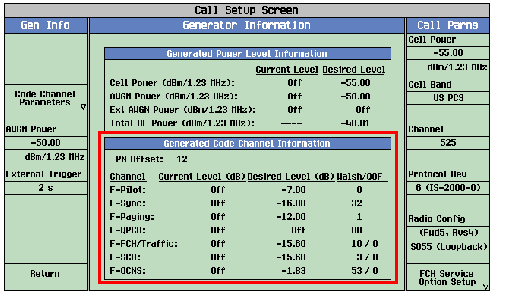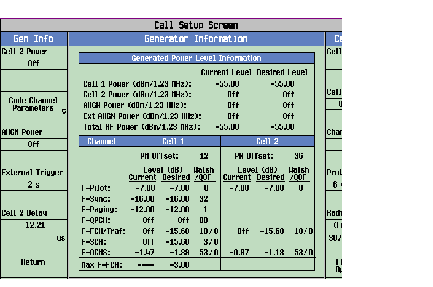Configuring Forward Channel Power Levels and Walsh Codes
Last updated: February 15, 2011
- Overview of Forward Code Channels Configuration
- Setting Code Channel Levels and Walsh Codes
- Current Level and Desired Level
- Considerations When Setting Code Channel States and levels
- Other Settings That Affect Code Channel Levels and States
- QOF, QOF Mask ID and QOF Set
- QOF Set In Use
Overview of Forward Code Channels Configuration
The test set provides controls over the forward channel levels and walsh codes. There are separate settings for each of the channel levels and states for IS-95 and IS-2000 system if supported for that protocol revision (see Protocol Revisions ).
In addition to the walsh codes and power levels that can be set or queried for the forward code channels, some channels also have other settings, such as F-FCH/Traffic channel data rate, etc. Forward Code Channels for IS-2000 and IS-95 Systems provides you the reference to the configuration information relating to the specific code channels.
| IS-2000 System | IS-95 System | How to Set the Related Parameters | |
|---|---|---|---|
| P_REV > = 7 | P_REV = 6 | P_REV < 6 | |
|
Configuring the Forward Pilot Channel (F-Pilot/Pilot)
(PN Offset setting information also included) |
|||
| Configuring the Forward Paging Channel (F-Paging/Paging) | |||
| Configuring the F-BCCH/F-CCCH Control Channels | |||
| Configuring the Forward Quick Paging Channel (F-QPCH) | |||
| Configuring the Forward Fundamental/Traffic Channel (F-FCH/Traffic) | |||
| Configuring the TDSO Supplemental Channel Information | |||
| Configuring the Forward Orthogonal Channel Noise Simulator (F-OCNS/OCNS) | |||
Setting Code Channel Levels and Walsh Codes
To set code channel levels and walsh codes (in addition to the F-QPCH) from the front panel operation, see How Do I Change Generator Information? . To set the F-QPCH levels, see A. Control Channel Parameters
The code channel levels and walsh codes you specified will be displayed in Generated Code Channel Information (for Test Application) window. To understand the differences between current level and desired level, see Current Level and Desired Level .
To set/query the code channel levels/states with GPIB commands, see Summary of GPIB Commands for Code Channel Levels .
See QOF, QOF Mask ID and QOF Set for more about QOF.
For the lab application , the test set has the ability to simulate two individual base stations, referred as Cell 1 and Cell 2 (see Generated Code Channel Information (for Lab Application) ). The Cell 1 used in the lab application is identical to the Cell used in the test application. For more information about Cell 2 code channels, see Configuring Cell 2 Used for Soft/Softer Handoff .
For the lab application , when a call is connected in FPC mode 000 (see FPC Mode ), the maximum FPC F-FCH level given indicates the upper limit of the F-FCH level (Ec/Ior) that the test set can be adjusted to according to the forward power control by the mobile station. See FPC Parameters for details.
Current Level and Desired Level
The test set allows you to set the relative power level (Ec/Ior) for all code channels (desired level) except for OCNS (orthogonal channel noise simulator). The relative power of the channels that are being generated at any given time must sum to 100% of the cell power. The OCNS Level is a calculated value used to balance the relative power levels to sum to 100% (see Configuring Cell Power and AWGN Power Levels ).
The relative power levels and states all have an associated "current" query-only result. The current result shows what is actually being generated by the test set at any given time. The code channel levels that you set (desired level) may differ from the current levels in the following situations:
- In Active Cell, any of the "On" channel states are not currently being generated due to the state of the call processing. For example, Current Traffic Level will be NAN when a call is not connected and will match that of the desired Traffic Level value when a call is connected.
- The associated code channel is never generated in the current test set state. For example, the F-BCCH is not generated in protocol revision 7 when current control channel is set to F-PCH/R-ACH (see Control Channels Configuration for details). In this case, the Current F-BCCH Level will be NAN regardless if its state is On or Off.
- Because the relative power levels of the different channels must add up to a 100% of the cell power, the test set performs an error checking of the code channel levels, called code level summation check. When any code channel level and state changed violates the rules (see Considerations When Setting Code Channel States and levels ) and results in an invalid set, a persistent error message is posted. In this case, the `Current' values will reflect the actual signals being generated (which will be the last set of valid channel levels you specified). In addition to the code channel levels/states, some other settings when changed also affect the code level summation check and may result in an invalid set (see Other Settings That Affect Code Channel Levels and States ).
| Current Level | Desired Level | |
|---|---|---|
|
CALL: QPCHannel:LEVel[:RTCell][:SELected]? (query only) |
||
|
CALL[:CELL[1]]:TRAFfic[:FORWard]:LEVel<[:SELected]|DIGital95> |
||
|
CALL:STATus:OCNSource[:CELL[1]][:LEVel][:SELected]? (current) |
CALL[:CELL[1]]:OCNSource:LEVel[:SELected]? (calculated) |
|
|
Max F-FCH |
CALL:STATus:FPControl:FCHannel:LEVel:MAXimum? | |
|
* For the lab application , when a call is connected in FPC mode 000 (see FPC Mode ), the current F-FCH/Traffic level and the current OCNS level reflect the average of F-FCH Level and the average of F-OCNS Level since last updated (the update rate is about 500 ms).
** For the lab application , when the test set is in FPC mode 000, the maximum F-FCH level given indicates the upper limit of the F-FCH level (Ec/Ior) that the test set can be adjusted to according to the forward power control by the mobile station. See FPC Parameters for details |
||
Considerations When Setting Code Channel States and levels
- Any code channel levels (except OCNS) that are ON must be no less than - 30 dB relative to Total RF Power ( Configuring Cell Power and AWGN Power Levels ).
- When OCNS level (calculated or current) is - 40 dB or less relative to Cell Power, the associated OCNS Level is turned off.
- When a code channel level/state changed results in an invalid set (i.e., the sum of the code channels + OCNS is above 100% of the cell power), a persistent error message is posted and the last valid values and states are used until the set becomes valid again.
- (For lab application and IS-2000 system only) when FPC mode is set to '000', the Maximum F-FCH Level (see FPC Parameters ) instead of the F-FCH Level will be used in the code level summation check. Moreover, the Maximum F-FCH Level must be no less than the F-FCH Level. Any invalid set will result in the current Maximum F-FCH Level different from the Maximum F-FCH Level you specified (see Current Level and Desired Level ).
- If a channel state is set to ON, the behavior will be different for Test Mode and Active Cell mode. In Active Cell mode, if the channel state parameter is ON, the channel will be generated according to the protocol state machine. For example, if the traffic (fundamental) channel state parameter is ON, the fundamental channel will be generated when a call is established and will not be generated anytime Call Status is Idle. In Test Mode, if the channel state is ON, the channel is being generated.
Other Settings That Affect Code Channel Levels and States
In addition to the change of code channel levels/states, the following settings also affect the code level summation check (see Current Level and Desired Level ) and may result in a rejection of the new setting due to an invalid set present.
- the rate set determined by the setting of the IS-2000 Radio Configuration and IS-95 Service Option.
- the setting of code channel data rate such as F-FCH data rate if this channel is being generated. See Control Channel Parameters (F-BCCH/F-CCCH/R-EACH) .
- the change of protocol revision that may change the control channels generated. For example, when the protocol revision is changed from 6 (IS-2000-0) to 7 (IS-2000-A), it may result in new control channels (F-BCCH/F-CCCH) generated if control channel configuration is set to F-BCCH/F-CCCH/R-EACH. See Operating Considerations for IS-2000 Protocol Revisions .
- the change of control channel configuration setting in protocol revision 7. For example, when the control channel configuration is changed from F-PCH/R-ACH to F-BCCH/F-CCCH/R-EACH, the F-BCCH and F-CCCH channels will take the place of the F-PCH to be involved in the code level summation check and may result in an invalid set. See Operating Considerations .
- (for lab application only) the change of the FPC mode setting (see FPC Parameters ). For example, when the FPC mode is changed from other modes to 000, the Maximum F-FCH Level will take the place of the F-FCH level and be involved in the code level summation check that may result in an invalid set.
QOF, QOF Mask ID and QOF Set
The IS-2000 system can use the Quasi-Orthogonal Functions (QOF) to expand the existing number of walsh codes. To use QOF, the walsh code is multiplied with a quasi-orthogonal mask (identified by the QOF mask ID, see 3GPP2 C.S0002 Table 3.1.3.1.18-1 for the QOF masks of each function), and following the walsh spreading, I and Q Channels are rotated by 90 degrees gated by another walsh code. The walsh and QOF assignment of code channels shall be such that each code channel is orthogonal or quasi-orthogonal to all other code channels in use.
QOF Set is a set of quasi-orthogonal functions generated by applying the same quasi-orthogonal masking function to the set of all walsh functions. Within a QOF set, orthogonality is preserved.
As specified in the standard, quasi-orthogonal functions are used with Radio Configurations 3, 4, 5, 6, 7, 8, 9, 11 and 12. The test set allows you to set the QOF Mask ID for FCH, SCH and OCNS channel. See Forward Code Channels for IS-2000 and IS-95 Systems on how to set the parameters for each of these channels.
QOF Set In Use
See QOF, QOF Mask ID and QOF Set .
This parameter defines the QOF Sets that are in use for the current cell. The three characters represent the bit masks for three QOF Sets (QOF_SET_1, QOF_SET_2 and QOF_SET_3). For example, setting the
QOF Set In Use
to
110
means that the test set will use the QOF_SET_1 and QOF_SET_2.
GPIB Commands: CALL[:CELL[1]]:QOFunction:SET:ACTive CALL:CELL2:QOFunction:SET:ACTive
Related Topics
How Do I Change Generator Information?
Configuring Cell Power and AWGN Power Levels
Troubleshooting Setting Power Levels
Configuring Cell 2 Used for Soft/Softer Handoff ( Lab Application Only )

